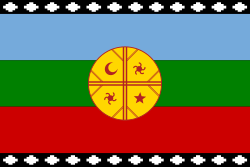Pehuenche
Pehuenche (or Pewenche, people of the "pehuen" or "pewen" in Mapudungun) are an indigenous people of South America. They live in the Andes primarily in south central Chile and adjacent Argentina. Their name derives from their dependence for food on the seeds of the pehuen or monkey-puzzle tree (Araucaria araucana). In the 16th century, the Pehuenche lived in the mountainous territory from approximately 34 degrees to 40 degrees south. Later they became Araucanized and partially merged with the Mapuche peoples. In the 21st century, they still retain some of their ancestral lands.
Culture
A Spanish writer first described the Pehuenche in 1558.
"These people do not sow. The sustain themselves by hunting in the valleys they occupy. There are many guanacos, jaguars, cougars, foxes, small deer, and mountain cats and birds of many species. They use bows and arrows for hunting. Their houses are four poles covered with skins. They move from place to place and have no permanent habitation...Their clothes are blankets made of animal skins.”[1]
That writer did not mention the primary food source of the Pehuenche: the harvest of the seeds of the monkey-puzzle tree (Araucaria araucana), locally called Pehuen.[2]
The Pehuenche adopted horse meat into their diet after feral horses of Spanish origin reached the eastern foothills of the Andes. These herds had developed in the humid pampa, after the Spanish abandoned Buenos Aires the second time in 1541.[3] At first, the Pehuenche hunted horses as any other game, but later they began to raise horses for meat and transport. To conserve horse meat, they processed it as charqui after being sun-dried in the high Andes.
Juan Ignacio Molina wrote in his Civic History of the Kingdom of Chile (1787) that the language and religion of the Pehuenche were similar to those of other Mapuche, but he described their dress as distinct. The men wore skirts rather than trousers, as well as earrings and manillas. Molina described them as nomadic ("vagabond" in his words) and the most industrious and laborious among "all the savages".[4]
See also
References
- ↑ Torrejon G., Fernando (2001), “Variables Geohistoricas en la Evolucion del Sistema Economico Pehuenche durante el Periodo Colonial,” Revista Universum, Universidad de Talca, No. 16, p. 222
- ↑ Aagesen, David L. (Jan. 1998), “On the Northern Fringe of the South American Temperate Forests: The History and Conservation of the Monkey-Puzzle Tree,” ‘Environmental History’, Vol. 3, No. 1, pp. 67-69
- ↑ "Archived copy". Archived from the original on 2009-03-13. Retrieved 2009-01-03.
- ↑ Juan Ignacio Molina (1787). Civic History of the Kingdom of Chile, pp. 222-226
| Wikimedia Commons has media related to Pehuenches. |
